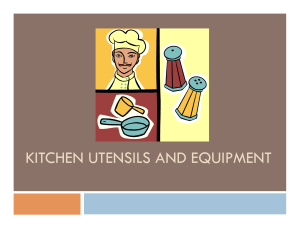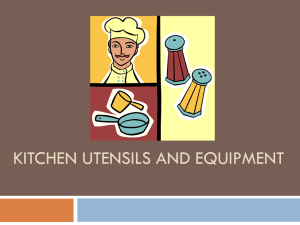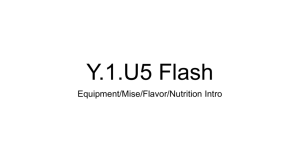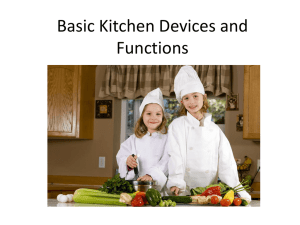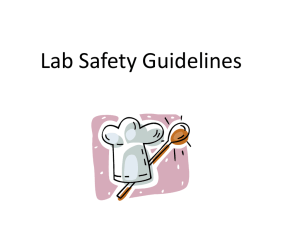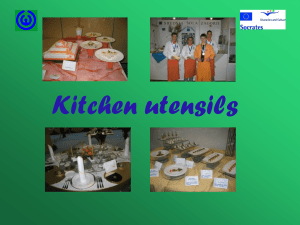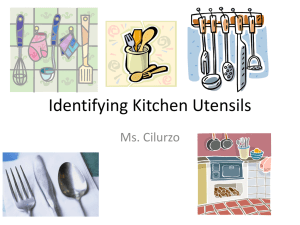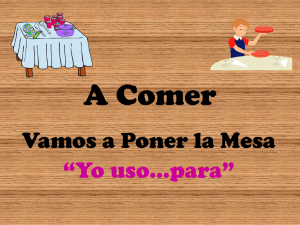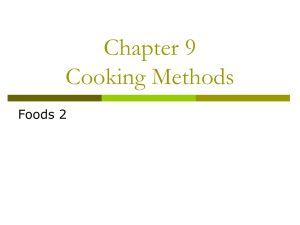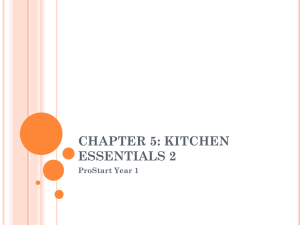Kitchen Utensils and Equipment
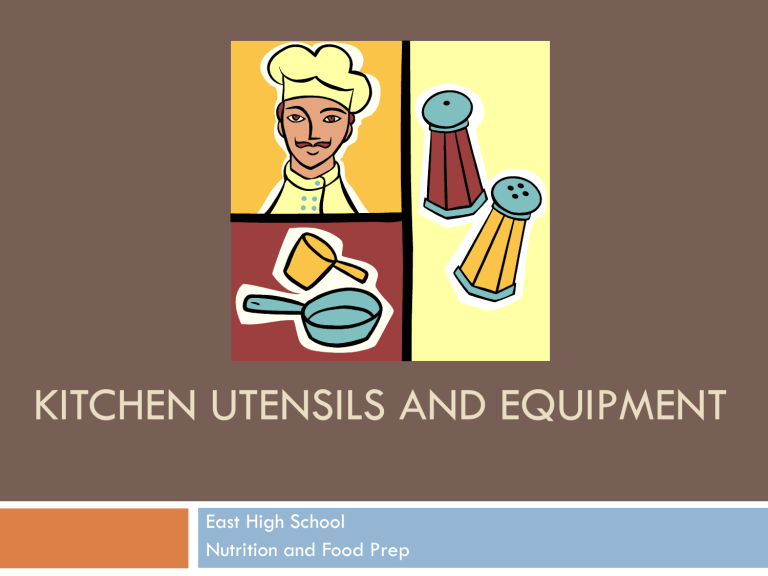
KITCHEN UTENSILS AND EQUIPMENT
East High School
Nutrition and Food Prep
Kitchen Gadgets Abound!
Thousands of kitchen utensils fill hundreds of general department stores and specialty shops
Do you need all of those gadgets?
No, generally they are all specialized versions of the basic three: KNIFE, FORK, SPOON!
Specialization=Convenience
Most utensils have been invented to make life more convenient
Some basic utensils make cooking fun because less time is spent actually preparing the food for cooking.
Even a microwave is just piece of kitchen equipment to make heating food easier!
Why learn these kitchen utensils?
Using the right tool for the job makes a carpenter’s work easier. They would not be able to pound many nails per hour if they were using a saw.
Our food preparation labs have specialized equipment that will make tasks easier, more efficient and produce products that are better quality than just using a knife, fork or spoon!
Here’s how we will learn the utensils:
Look for three elements:
A picture of the utensil in the upper right.
The standard name for the utensil or piece of equipment in the title.
Lastly, some text with examples of how it is used in the kitchen- in other words, the function of the item.
You should fill in these names and functions on your worksheet as we go along!
1. Wooden Spoon
Stirring utensil that will
NOT conduct heat as you stir!
Probably one of the oldest cooking utensils, which was easily carved from wood with a simple knife.
2. Slotted Spoon
Utensil for lifting solid foods such as vegetables from liquid.
3. Ladle
Dipper for liquids that need to be transported.
4. Rubber Scraper
Scrapes a bowl clean
BUT could melt if used in a saucepan.
5. Metal Spatula
Utensil for lifting and turning items like pancakes and meat.
Should NOT be used in a nonstick pan.
6. Wire Whisk
Simplest tool for beating and stirring light mixtures
Metal whisk should
NOT be used in a nonstick pan. Instead used a plastic or rubber whisk.
7. Cooking Fork
Tool for lifting meat or large pieces of food from pans.
8. Tongs
Safety pinchers to easily and safely grab food items.
9. Dry Measuring Cups
Graduated cups to assure that the right amount of dry ingredients are used.
Dry ingredients include what food items?
Why shouldn’t liquid go in these?
Remember the standard set: ¼ cup, 1/3 cup, ½ cup, 1 cup.
10. Measuring Spoons
Graduated spoons to assure the right amount of a small ingredient is used.
Can be used for wet
OR dry ingredients
Remember the standard set:
¼ teaspoon, ½ teaspoon,
1 teaspoon, 1 tablespoon
11. Liquid Measuring Cup
Measuring device for
LIQUIDS ONLY!
Bend down to check it at eye level!
Come in various sizes:
1 cup, 2 cups, 4 cups and 8 cups or more!
12. Straight-edge Spatula
A flexible tool for leveling off ingredients or frosting a cake or cookies.
13. Pastry Blender
Tool for cutting shortening or butter into flour for flaky products like biscuits or pie crust.
14. Potato Masher
Tool for mashing potatoes and other items.
15. Decorating Bags & Tips
Bag with assorted tips for decorating cakes, deviled eggs and other desserts.
16. Rolling Pin
Cylinder which eases the rolling of dough and pastries.
Can be made or wood or plastic.
17. Sifter
Wire mesh and rotating bars for breaking up lumps or loosening flour.
18. Chef’s Knife or French Knife
Large knife for chopping and cutting large items like meat and vegetables.
19. Paring Knife
Small knife for peeling fruits & vegetables or making other small cuts such as garnishes.
20. Bread Knife
Serrated blade for slicing through bread.
Never needs sharpening.
21. Sharpening Steel
Flint type rod for sharpening blades of knives.
22. Can Opener
Bottle openers, handheld crank openers and electric can openers all making opening sealed cans easier.
23. Kitchen Shears
Heavy scissors for cutting meat, dough, pizza and fresh herbs.
Can also loosen bottle lids and small jars.
Cracks nuts and some shellfish.
24A. Pizza Cutter
Heavy blade used for cutting pizza and other bar cookies.
24B. Pastry Wheel
Special blade used to cut dough or pie crusts into strips
Can have a straight or fluted edge.
25. Melon Baller
Round tool for cutting melons.
“Parisienne Knife” is the traditional French term for this utensil.
26. Vegetable Peeler
Thin blade to remove the outer surface of fruit and vegetables.
Prevents waste and loss of nutrients.
27. Grater
Various holes and blades which cut cheese and vegetables into thin strips or slices.
28. Cutting Boards
Wood, Glass or Plastic surface for protecting counters when cutting foods.
Glass should never be used because it damages knives.
Plastic is the most sanitary because bacteria can live in wood cutting boards.
Make sure to buy color coded boards for food safety!
29. Oven Mitts and Hot Pads
Insulated fabric gloves used to protect hands when handling hot items.
30. Cooling Racks
Wire racks for cooling hot warms.
31. Muffin Pans
An oblong pan with round depressions for baking muffins and cupcakes.
32. Cookie Sheet
A flat baking sheet for baking cookies.
33. Jelly Roll Pan
A flat baking sheet with sides for baking bar cookies and other baked items.
34. Loaf Pan
A deep pan approximately 4 by 9 inches used to bake quick and yeast breads, meatloaf and other items.
35. Cake Pans
Various sized pans used for baking identified as width by length in inches
Common ones are:
9”x 13” Oblong
9”x 9” Square
9” Round
36. Tube Pan
Pan with a hollow tube in the center allowing for the cake to rise and yet the center to bake evenly.
Some even separate to make removing the cake easier!
37. Casserole or Baking Dishes
Glass, ceramic or metal dishes that may also have a cover to fit.
Oven safe to cook large quantities of food for long periods of time.
38. Skillet Fry Pan
Cast iron, metal or glass pan with low sides and a handle used for broiling foods or cooking in a small amount of fat.
39. Saucepan
A deep cooking pan with a handle and lid for boiling simmering and steaming foods.
40. Steamer Basket
A basket which folds and unfolds to conform to the size of a saucepan and keeps the food above boiling water to allow steam to cook the food.
41. Colander
A bowl with holes used to drain pasta and other liquids from food.
42. Strainer
A fine wire mesh used to drain liquids from smaller amounts of food.
43. Double Boiler
Two pans that fit together so that food can be cooked over boiling water without burning.
Great for chocolate or sauces.
44. Griddle
A skillet without sides used for grilling sandwiches and making pancakes.
45. Dutch Oven
A large, heavy pot or kettle with a tight fitting lid used for slow cooking foods on the stovetop or in the oven for long periods of time.
46. Kitchen Thermometers
A variety of thermometers to read the temperature of food or kitchen equipment
Very important to use when cooking meat to make sure meat is safe to eat!
47. Electric Stand Mixer
An appliance which can mix, beat and knead batters and dough.
Wire whisk for beating
Flat beater for blending
Dough hook for mixing bread and heavy dough.
Review
Learn to identify and use these utensils so you’ll be a successful chef!
Quiz on Kitchen
Equipment next time!
